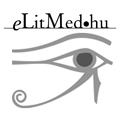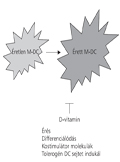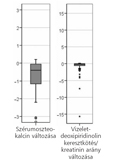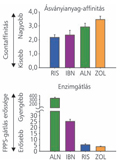The eLitMed.hu medical portal uses computer cookies for convenient operation. Detailed information can be found in the Cookie-policy.
Ca&Bone - 2009;12(03)
Content
[Vitamin D in autoimmun disorders: the immunregulatory effect of vitamin D and therapeutic opportunities]
[There is recent evidence that genetic and environmental factors play an important role in the development of autoimmune diseases. Vitamin D deficiency is one of the environmental factors that may play a role in developing autoimmune diseases. Low vitamin D status has been implicated in the etiology of autoimmune diseases such as multiple sclerosis, systemic lupus erythematosus, rheumatoid arthritis, inzulin dependent diabetes mellitus, and inflammatory bowel disease. Experimentally, vitamin D deficiency results in an increased incidence of autoimmune disease. The authors discuss the accumulating evidence pointing to a link between vitamin D and autoimmunity. The optimal level of vitamin D intake is necessary to normalize the immune functions and it plays an important role in the development of self-tolerance. Targets for vitamin D in the immune system have been identified and the mechanism of vitamin D mediated immunoregulation is beginning to be understood. On the basic of recent knowledge, vitamin D causes a decrease in Th1-driven autoimmune response and repairs the function of regulatory T cells. Increased vitamin D intakes might decrease the incidence and severity of autoimmune diseases.]
[Overcome of bisphosphonate resistance with alphacalcidol: results of a one year, open follow-up study]
[INTRODUCTION - A considerable part of osteoporotic patients do not respond satisfactorily to adequate treatment with a bisphosphonate plus supplementation with calcium and conventional vitamin D3. This study intended to determine whether the replacement of vitamin D3 with alphacalcidol results in any BMD increase, i.e. is it possible to overcome resistance to bisphosphonates. PATIENTS AND METHOD - In 76 patients unresponsive to the combination of alendronate and conventional vitamin D3, the latter had been replaced with alphacalcidol (0.5 μg/day), and then the patients were followed up for a year. Clinical and laboratory parameters were recorded at baseline and after one year of treatment; and their changes were analysed by statistical methods. RESULTS - After treatment for one year, Wilcoxon test revealed a small but statistically significant (p<0.001) increase in the BMD values of the forearm (+2.2%) and lumbar vertebrae (+1.4%). At the end of the treatment period, the following, significant changes were observed compared to baseline (median values): serum calcium level increased by 0,06 mmol/l; serum phosphorus level decreased by 0.05 mmol/l, serum alkaline phosphatase activity decreased by 13 U/l, and urinary calcium/creatinine ratio in first-voided morning urine increased by 0.1. Additionally, serum PTH level decreased by 10.7 pg/ml (median). Serum levels of osteocalcin decreased by 0.4 ng/ml, along with the urinary D-Pyr /kreatinine ratio by 0.2 nmol/mmol (median). No significant increase of adverse events occurred. DISCUSSION - As suggested by our results, combination therapy with alendronate and alfacalcidol increases bone density and improves the biochemical markers of bone turnover - without any substantial increase in the incidence of adverse effects.]
[Hip fractures in Hungary between 2001 and 2008 - Assessment of the beneficial effect of bisphosphonates on the risk of hip fractures on the basis of Hungarian data]
[The overall prevalence of osteoporosis in developed countries is estimated to be 9-15%. Mortality in the first year after the fracture is 15-20%, and half of the survivors remain partly or fully dependent on others’ support. Owing to the increasing life expectance and the diseases of civilisation, the incidence of osteoporotic fractures is expected to double in the next thirty years. The network of centers that has been developed since 1995 under the National Osteoporosis Program and the accreditation system of the National Osteoporosis Center provided up-to-date education of the physicians (densitometry assistants) who work within the network. The diagnostic restrictions followed by the reduction of support to 70% since 2006 fall resulted in a dramatic reduction in the number of treated patients.]
[Modelling of burden of femoral neck fracture from purchaser’s point of view]
[OBJECTIVE - This study provides a model of the treatment cost of femoral neck fracture and financial burden of the annual fracture cases at 2009 financial level from health insurance point of view. METHOD - The costs of the treatment of femoral neck fractures are modelled according to the actually OEP reimbursed types of care including acute inpatient care, chronic inpatient care, outpatient care, pharmaceuticals and medical devices, home care (nursing), cost of travelling or transport and the disability to work. Cases healing following primary treatment (without complications) and cases with complications are examined separately. The costs of most common complications with large surgical operation are calculated. RESULTS - The cost of patients in active age-groups cured by primary treatment can vary in a range of 1.010.110- 1.479.034 HUF depending on cost level of individual care and utilization, while the cost of patients in retired agegroups (pensioners) can vary in a range 635.350- 1.104.274 HUF. The cost of patients with complication (primary treatment and complication) in active agegroups can reach. 1 858.438-3.133.096 HUF depending on cost level of individual care and utilization, while the cost of patients in retired age-groups (pensioners) can reach 1.108.918-2.383.576 HUF. According to our model calculations, the cost of primary treatment of femoral neck fractures and essential further treatment represents an annual burden of 4.373.857.668-6.247.717.438 HUF for the health insurance system. CONCLUSION - In order to reduce the incidence of hip fractures one should emphasize the importance of current and future interventions, which projects the possibility of reducing the financial burden at societal level. The analysis of financial burden could serve as a base for health-economics studies, by elaborating a cost-effective strategy supported by professional and political decision makers.]
[The risk factors of osteoporosis and osteoporotic fractures in Hungarian women: the results of the NOKK study]
[INTRODUCTION - It is widely accepted from Western European and the US studies that race and geography significantly affect the risk for osteoporosis. Less is known about similar associations in Eastern European subjects. Our aim was to describe the risk factors for osteoporotic fractures and osteoporosis in a selected female population in a cross-sectional, multi-center study performed under the guidance of the Hungarian Society for osteoporosis and Osteoarthrology. MATERIAL AND METHOD - From 10 randomly selected regional osteoporosis centers, altogether 2602 women >18 years of age, referred with any osteoarthrological reason, participated. During their visit data on risk factors, blood pressure, anthropometry, and bone mineral density were collected. RESULTS - Using multiple regression we found that older age, lower diastolic blood pressure, family history of bone fracture, fall in previous year and lower T-score were independently related to fractures. Independent risk factors for femoral osteoporosis included older age, lower weight, family history of fracture, less physical activity, fall in the previous year and glucocorticoid treatment. DISCUSSION - Our study is the first large-scale epidemiological survey describing risk factors of osteoporosis and fractures in a Hungarian female population. Our data may suggest that lower diastolic blood pressure might be related to osteoporotic fractures.]
1.
Clinical Neuroscience
[Headache registry in Szeged: Experiences regarding to migraine patients]2.
Clinical Neuroscience
[The new target population of stroke awareness campaign: Kindergarten students ]3.
Clinical Neuroscience
Is there any difference in mortality rates of atrial fibrillation detected before or after ischemic stroke?4.
Clinical Neuroscience
Factors influencing the level of stigma in Parkinson’s disease in western Turkey5.
Clinical Neuroscience
[The effects of demographic and clinical factors on the severity of poststroke aphasia]1.
2.
3.
4.
5.










